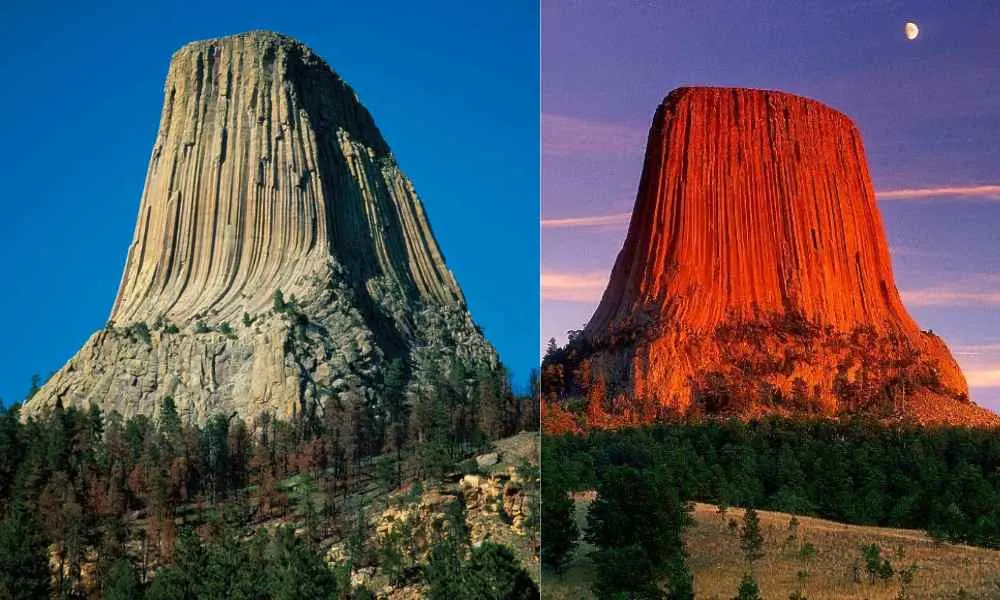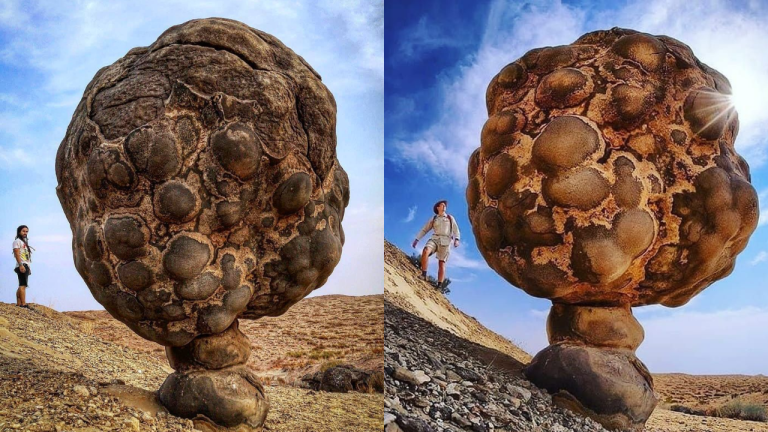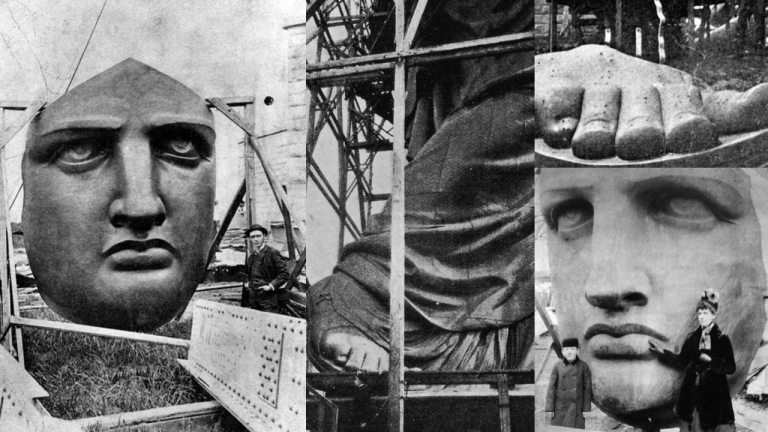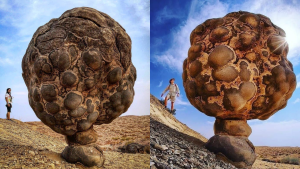Ever heard of a rock formation so fascinating that it seems out of this world? The Devil’s Tower National Monument is exactly that. It is a geological marvel that shoots straight out of the prairies surrounding the Black Hills. Shrouded in mystery, Devils Tower is formed of a rock called phonolite porphyry, a less sparkly granite with no quartz. Devils tower is widely known as America’s first national monument and is a sacred place among many native American tribes. It is still very much a focal point of curiosity and awe. Let’s have a closer look at the stories surrounding the tower.
Unraveling the Mystery: What Makes Devil’s Tower Special?
Devil’s Tower stands as a solitary monolith against the Wyoming skyline. Its massive, columnar structure rises for over 867 feet from its base, with a summit 5,112 feet above sea level. This monument is mainly composed of igneous rock and has a large number of parallel cracks.
In 1906, the US president Theodore Roosevelt named it as America’s first national monument. The monument is spread across an area of roughly 1,347 acres. The missing apostrophe in “Devils Tower” is actually a clerical error. However, the error never got corrected making its name remain as “Devils Tower,” even to this day.
Geologists theorize that Devil’s Tower is an igneous intrusion. Meaning that magma rose from the Earth’s crust but cooled and solidified before reaching the surface. This contrasts with other formations like sedimentary buttes or volcanic lava flows. Its uniqueness lies in the geometric precision of its columns which is unmatched by any other known rock formation.
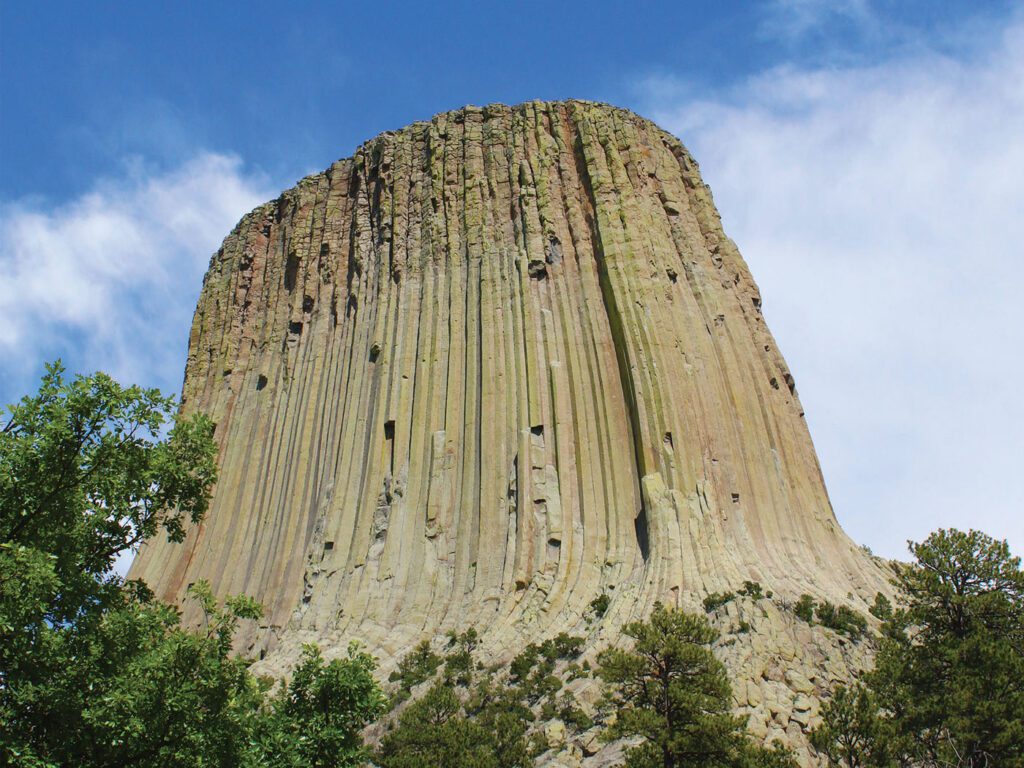
The Legends and Lore: True Stories Behind Devil’s Tower
For many Native American tribes, Devil’s Tower is more than just a rock. It’s a sacred site, steeped in legend. The Kiowa tribe tells of seven girls who were chased onto a low rock to escape attacking bears. As they prayed for help, the rock grew towards the heavens, and the girls became the Pleiades star cluster.
Similarly, the Lakota have a tale about a boy who turned into a bear and scratched a rock while chasing some girls, explaining the tower’s unique markings.
The Lakota tribe also speaks of a brave warrior who would fast and pray to the Great Spirit in the wilderness. He once took a buffalo skull and worshipped at the bottom of the Devils Rock for two days. Suddenly, he found himself on top of the rock not knowing how he got there. He became frightened as he had no way of climbing down. He fell asleep while appealing to the Great Spirit. Then he mysteriously found himself again at the bottom of the rock. The warrior of the Lakota tribe has also mentioned a gigantic bear, which he believes explains the claw marks-like formation of the rock.
Many tribes refer to the rock by many names like “Aloft on a Rock,”“Tree Rock,” “Bear Lodge,” “Bear Lodge Butte,” etc. However, the rock is mainly known among many as “Mateo Tepee,” which stands for something like “Bear Wigwam,” or “Bear Lodge.” The stories, rich in cultural heritage, underscore the spiritual significance of Devil’s Tower to numerous Native American communities.
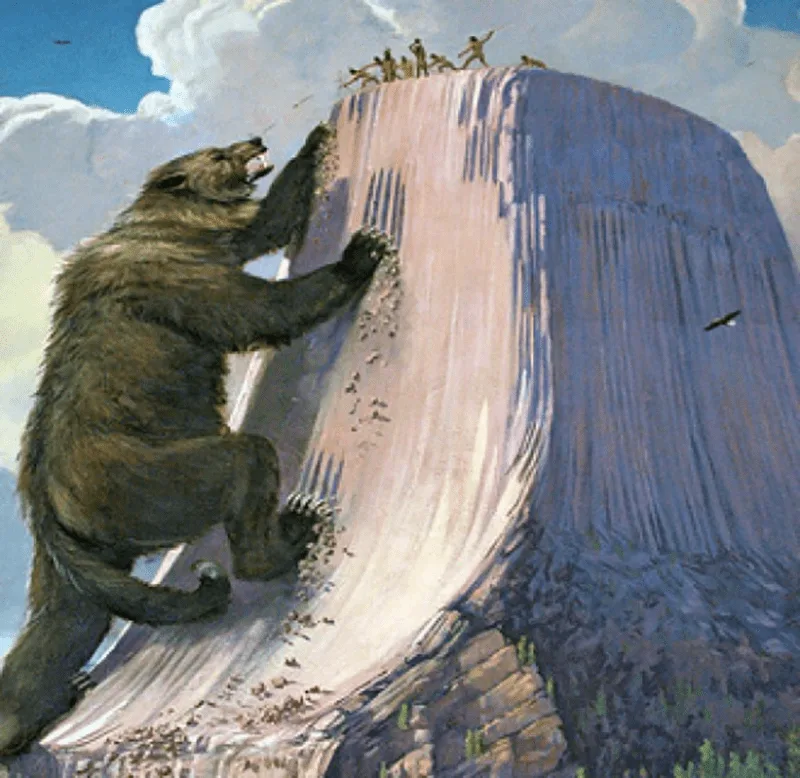
The Name Debate: Why Is It Called Devil’s Tower?
The name “Devil’s Tower” was attributed by Colonel Richard Irving Dodge in 1875 when his interpreter reportedly misinterpreted a Native American name to mean “Bad God’s Tower.” This naming of the sacred monument has been challenged over the years. This is because many Native Americans and activists advocate for a name that respects the site’s sacred nature.
The movement to rename it to a more culturally appropriate name is a topic of ongoing debate, reflecting the complex history and cultural dynamics of the region.
The Adventurers’ Paradise: Climbing the Devil’s Tower
Devil’s Tower is not just a site of historical and cultural significance. It’s also a magnet for climbers. Since its first recorded ascent in 1893, it has become a popular climbing destination. The tower presents a unique challenge due to its rare columnar jointing and sheer walls.
However, climbers are encouraged to respect the site’s sacred status. Especially during June, when many tribes conduct ceremonies. Connecting with the summer solstice, tribes perform various pipe ceremonies, sun dances, and vision quests. This balance of adventure and respect is a testament to the multifaceted significance of Devil’s Tower.
A Monument Beyond Borders: Devil’s Tower in Wyoming and Beyond
Devils Tower’s imposing figure has not only drawn tourists from around the world, but it has also captured the imagination of many. It has featured in movies and pop culture, most notably in Steven Spielberg’s “Close Encounters of the Third Kind.” The monument’s influence extends beyond its physical borders, marking its place in both geological and cultural landscapes.

Inside the Tower: Unveiling the Mysteries Within
Contrary to popular myth, the Devil’s Tower is not hollow. Its interior, like its exterior, consists of dense, igneous rock. While the exterior is characterized by its parallel columns, the interior is assumed to be similar, though it remains largely unexplored due to the monument’s protected status. The mystery of what lies within the tower’s dense rock continues to be a point of fascination.
Preserving a Sacred Site: Conservation and Respect
Devil’s Tower stands as a symbol of natural beauty and cultural significance. National Park Service and Native American tribes take collaborative approaches to preserve the site. This cooperation is crucial in maintaining the site’s integrity as a sacred landmark and a geological wonder. Visitors are encouraged to experience the monument with a sense of reverence and respect, understanding its significance to various cultures and its role in the natural world.
Conclusion
Devil’s Tower, America’s first national monument, is a convergence of natural wonder, cultural depth, and historical significance. Its enigmatic presence invites exploration and respect, bridging the gap between past and present, science and spirituality. As we delve into its stories and marvel at its stature, it’s essential to remember the importance of preserving such sites – they are not just physical landmarks, but beacons of our shared heritage.
Also read,
Rift Valleys That Run Across The Earth | Shocking Shift of Earth’s Tectonic Plates!


